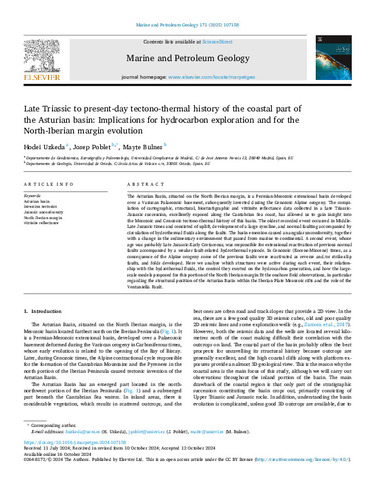Late Triassic to present-day tectono-thermal history of the coastal part of the Asturian basin: Implications for hydrocarbon exploration and for the North-Iberian margin evolution
Autor(es) y otros:
Palabra(s) clave:
Asturian basin, Inversion tectonics, Jurassic unconformity, North Iberian margin, vitrinite reflectance
Fecha de publicación:
Versión del editor:
Citación:
Resumen:
The Asturian Basin, situated on the North Iberian margin, is a Permian-Mesozoic extensional basin developed over a Variscan Palaeozoic basement, subsequently inverted during the Cenozoic Alpine orogeny. The compilation of cartographic, structural, biostratigraphic and vitrinite reflectance data collected in a Late Triassic- Jurassic succession, excellently exposed along the Cantabrian Sea coast, has allowed us to gain insight into the Mesozoic and Cenozoic tectono-thermal history of this basin. The oldest recorded event occurred in Middle- Late Jurassic times and consisted of uplift, development of a large syncline, and normal faulting accompanied by circulation of hydrothermal fluids along the faults. The basin emersion caused an angular unconformity, together with a change in the sedimentary environment that passed from marine to continental. A second event, whose age was probably Late Jurassic-Early Cretaceous, was responsible for extensional reactivation of previous normal faults accompanied by a weaker fault-related hydrothermal episode. In Cenozoic (Eocene-Miocene) times, as a consequence of the Alpine orogeny some of the previous faults were reactivated as reverse and/or strike-slip faults, and folds developed. Here we analyse which structures were active during each event, their relationship with the hydrothermal fluids, the control they exerted on the hydrocarbon generation, and how the largescale models proposed for this portion of the North Iberian margin fit the onshore field observations, in particular regarding the structural position of the Asturian Basin within the Iberian Plate Mesozoic rifts and the role of the Ventaniella Fault.
The Asturian Basin, situated on the North Iberian margin, is a Permian-Mesozoic extensional basin developed over a Variscan Palaeozoic basement, subsequently inverted during the Cenozoic Alpine orogeny. The compilation of cartographic, structural, biostratigraphic and vitrinite reflectance data collected in a Late Triassic- Jurassic succession, excellently exposed along the Cantabrian Sea coast, has allowed us to gain insight into the Mesozoic and Cenozoic tectono-thermal history of this basin. The oldest recorded event occurred in Middle- Late Jurassic times and consisted of uplift, development of a large syncline, and normal faulting accompanied by circulation of hydrothermal fluids along the faults. The basin emersion caused an angular unconformity, together with a change in the sedimentary environment that passed from marine to continental. A second event, whose age was probably Late Jurassic-Early Cretaceous, was responsible for extensional reactivation of previous normal faults accompanied by a weaker fault-related hydrothermal episode. In Cenozoic (Eocene-Miocene) times, as a consequence of the Alpine orogeny some of the previous faults were reactivated as reverse and/or strike-slip faults, and folds developed. Here we analyse which structures were active during each event, their relationship with the hydrothermal fluids, the control they exerted on the hydrocarbon generation, and how the largescale models proposed for this portion of the North Iberian margin fit the onshore field observations, in particular regarding the structural position of the Asturian Basin within the Iberian Plate Mesozoic rifts and the role of the Ventaniella Fault.
Patrocinado por:
We acknowledge financial support by the grant AYUD/2021/51293 funded by the Government of Asturias, and the research project PID2021-126357NB-100 funded by the Spanish Ministry of Science and Innovation.
Colecciones
- Artículos [37538]
- Geología [551]
- Investigaciones y Documentos OpenAIRE [8403]
Ficheros en el ítem





